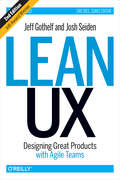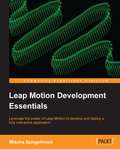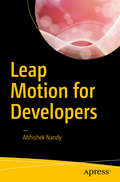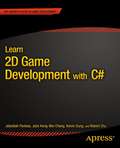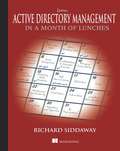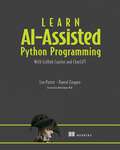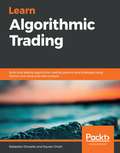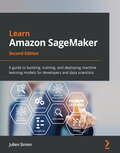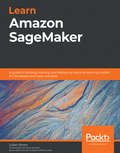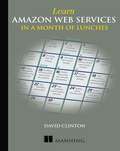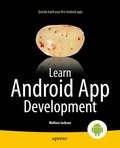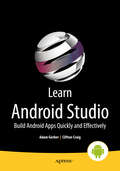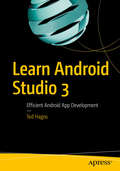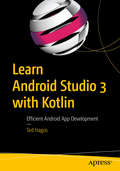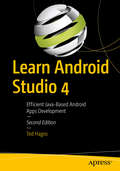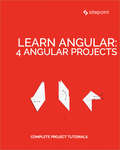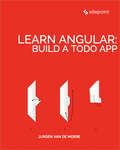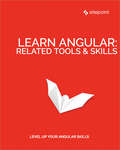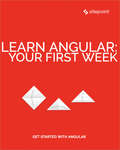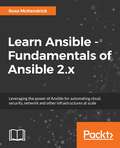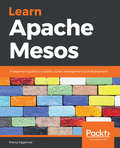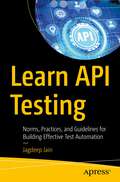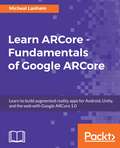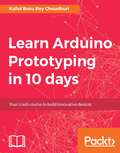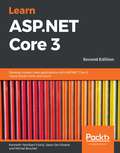- Table View
- List View
Lean UX: Designing Great Products with Agile Teams
by Josh Seiden Jeff GothelfUX design has traditionally been deliverables-based. Wireframes, site maps, flow diagrams, content inventories, taxonomies, mockups helped define the practice in its infancy.Over time, however, this deliverables-heavy process has put UX designers in the deliverables business. Many are now measured and compensated for the depth and breadth of their deliverables instead of the quality and success of the experiences they design. Designers have become documentation subject matter experts, known for the quality of the documents they create instead of the end-state experiences being designed and developed.So what's to be done? This practical book provides a roadmap and set of practices and principles that will help you keep your focus on the the experience back, rather than the deliverables.Get a tactical understanding of how to successfully integrate Lean and UX/DesignFind new material on business modeling and outcomes to help teams work more strategicallyDelve into the new chapter on experiment designTake advantage of updated examples and case studies
Leap Motion Development Essentials
by Mischa SpiegelmockThis book is a fast-paced guide with practical examples that aims to help you understand and master the Leap Motion SDK.This book is for developers who are either involved in game development or who are looking to utilize Leap Motion technology in order to create brand new user interaction experiences to distinguish their products from the mass market. You should be comfortable with high-level languages and object-oriented development concepts in order to get the most out of this book.
Leap Motion for Developers
by Abhishek NandyDevelop apps and games using the Leap Motion sensor. This book starts with a brief introduction to Leap Motion, then covers getting the Leap Motion working and setting up a Leap Motion development environment. Leap Motion for Developers also covers the life cycle of how you interact with Leap Motion and the workflow of making a complete app. You'll see how to use different programming languages for simple and steady development. The next part of the book walks through the basics of Leap Motion with Python and Java. We will then work on using Leap Motion with Unity, where we will build an app using Unity and then add different functionality to it. In the last part we cover Unreal 4, Processing, and JavaScript for Leap Motion. What You Will Learn Look at the basics of Leap Motion Develop apps for the Leap Motion sensor See how different languages work with Leap Motion Discover the future of Leap Motion Who This Book Is For Students, developers, game developers, and tech enthusiasts.
Learn 2D Game Development with C#
by Jebediah Pavleas Jack Keng-Wei Chang Kelvin Sung Robert Zhu2D games are hugely popular across a wide range of platforms and the ideal place to start if you're new to game development. With Learn 2D Game Development with C#, you'll learn your way around the universal building blocks of game development, and how to put them together to create a real working game. C# is increasingly becoming the language of choice for new game developers. Productive and easier to learn than C++, C# lets you get your games working quickly and safely without worrying about tricky low-level details like memory management. This book uses MonoGame, an open source framework that's powerful, free to use and easy to handle, to further reduce low-level details, meaning you can concentrate on the most interesting and universal aspects of a game development: frame, camera, objects and particles, sprites, and the logic and simple physics that determines how they interact. In each chapter, you'll explore one of these key elements of game development in the context of a working game, learn how to implement the example for yourself, and integrate it into your own game library. At the end of the book, you'll put everything you've learned together to build your first full working game! And what's more, MonoGame is designed for maximum cross-platform support, so once you've mastered the fundamentals in this book, you'll be ready to explore and publish games on a wide range of platforms including Windows 8, MAC OSX, Windows Phone, iOS, Android, and Playstation Mobile. Whether you're starting a new hobby or considering a career in game development, Learn 2D Game Development with C# is the ideal place to start. What you'll learn Know your way around the world of game design and the process of designing a game from scratch. Understand the basic architecture of a 2D game engine and develop your own game library. Work with the MonoGame framework and use it to build your own 2D interactive games. Learn and implement simple in-game pseudo autonomous behaviors. Understand and implement the math and physics underlying realistic game interactions. Give your game impact with graphic effects, and audio and special effects. Who this book is for This book is perfect for game enthusiasts, hobbyists, and anyone who is interested in building interactive games but is unsure of how to begin. It assumes no background in computer graphics or game development, but readers should be familiar with C# or another object-oriented language. Table of Contents Introducing 2D Game Development in C# Getting to Know the MonoGame Framework 2D Graphics, Coordinates, and Game State Getting Things Moving Pixel-Accurate Collisions Game Object States and Semiautonomous Behaviors Sprites, Camera, Action! Particle Systems Building Your First 2D Game
Learn Active Directory Management in a Month of Lunches
by Richard SiddawaySummaryLearn Active Directory Management in a Month of Lunches is a practical, hands-on tutorial designed for IT pros new to Active Directory. It skips the theory and concentrates on the day-to-day administration tasks you need to know to keep your network running smoothly. Just set aside an hour a day for a month—lunchtime would be perfect—and you'll be comfortable and productive with Active Directory before you know it.About the BookAt the heart of your Windows network is Active Directory, the control center for administration, security, and other core management functions. If you're new to Active Directory administration—or if you find yourself unexpectedly thrust into that role—you'll need to get up to speed fast.Learn Active Directory Management in a Month of Lunches is a hands-on tutorial designed for IT pros new to Active Directory. Without assuming previous administration experience, the book starts by walking you through the most important day-to-day system management tasks. You'll learn how to administer AD both from the GUI tools built into Windows and by using PowerShell at the command line. Along the way, you'll touch on best practices for managing user access, setting group policies, automating backups, and more.This book assumes no prior experience with Active Directory or Windows administration. Examples are based in Windows Server 2012Purchase of the print book includes a free eBook in PDF, Kindle, and ePub formats from Manning Publications.What's InsideADM tasks you'll need every dayGUI and command line techniquesContent tested by new administratorsWell-illustrated, clearly explained examplesAbout the AuthorRichard Siddaway is an experienced all-around Windows administrator with two decades of experience. He's the author of PowerShell in Practice andPowerShell and WMI, and coauthor of PowerShell in Depth.Table of ContentsPART 1 MANAGING ACTIVE DIRECTORY DATABefore you beginCreating user accountsManaging user accountsManaging groupsTroubleshooting users and groupsManaging computer accountsManaging organizational unitsPART 2 MANAGING GROUP POLICYCreating Group PoliciesManaging Group PoliciesFine-grained password policiesPART 3 MANAGING THE ACTIVE DIRECTORY SERVICECreating domain controllersManaging domain controllersProtecting AD data Security: Default groups and delegationManaging DNSManaging sites and subnetsAD replicationManaging AD trustsPART 4 MAINTENANCE AND TROUBLESHOOTINGTroubleshooting your AD Maintaining and monitoring Active DirectoryFuture work and final examInto the cloud
Learn AI-assisted Python Programming: With GitHub Copilot and ChatGPT
by Leo PorterWriting computer programs in Python just got a lot easier! Use AI-assisted coding tools like GitHub Copilot and ChatGPT to turn your ideas into applications faster than ever.AI has changed the way we write computer programs. With tools like Copilot and ChatGPT, you can describe what you want in plain English, and watch your AI assistant generate the code right before your eyes. It&’s perfect for beginners, or anyone who&’s struggled with the steep learning curve of traditional programming. In Learn AI-Assisted Python Programming: With GitHub Copilot and ChatGPT you&’ll learn how to: Write fun and useful Python applications—no programming experience required! Use the Copilot AI coding assistant to create Python programs Write prompts that tell Copilot exactly what to do Read Python code and understand what it does Test your programs to make sure they work the way you want them to Fix code with prompt engineering or human tweaks Apply Python creatively to help out on the job Learn AI-Assisted Python Programming: With GitHub Copilot and ChatGPT is a hands-on beginner&’s guide that is written by two esteemed computer science university professors. It teaches you everything you need to start programming Python in an AI-first world. You&’ll hit the ground running, writing prompts that tell your AI-assistant exactly what you want your programs to do. Along the way, you&’ll pick up the essentials of Python programming and practice the higher-level thinking you&’ll need to create working apps for data analysis, automating tedious tasks, and even video games. Foreword by Beth Simon, Ph.D. About the technology The way people write computer programs has changed forever. Using GitHub Copilot, you describe in plain English what you want your program to do, and the AI generates it instantly. About the book This book shows you how to create and improve Python programs using AI—even if you&’ve never written a line of computer code before. Spend less time on the slow, low-level programming details and instead learn how an AI assistant can bring your ideas to life immediately. As you go, you&’ll even learn enough of the Python language to understand and improve what your AI assistant creates. What's inside Prompts for working code Tweak code manually and with AI help AI-test your programs Let AI handle tedious details About the reader If you can move files around on your computer and install new programs, you can learn to write useful software! About the author Dr. Leo Porter is a Teaching Professor at UC San Diego. Dr. Daniel Zingaro is an Associate Teaching Professor at the University of Toronto. The technical editor on this book was Peter Morgan. Table of Contents 1 Introducing AI-assisted programming with Copilot 2 Getting started with Copilot 3 Designing functions 4 Reading Python code – Part 1 5 Reading Python Code – Part 2 6 Testing and prompt engineering 7 Problem decomposition 8 Debugging and better understanding your code 9 Automating tedious tasks 10 Making some games 11 Future directions
Learn Algorithmic Trading: Build and deploy algorithmic trading systems and strategies using Python and advanced data analysis
by Sebastien Donadio Sourav GhoshUnderstand the fundamentals of algorithmic trading to apply algorithms to real market data and analyze the results of real-world trading strategies Key Features Understand the power of algorithmic trading in financial markets with real-world examples Get up and running with the algorithms used to carry out algorithmic trading Learn to build your own algorithmic trading robots which require no human intervention Book Description It's now harder than ever to get a significant edge over competitors in terms of speed and efficiency when it comes to algorithmic trading. Relying on sophisticated trading signals, predictive models and strategies can make all the difference. This book will guide you through these aspects, giving you insights into how modern electronic trading markets and participants operate. You'll start with an introduction to algorithmic trading, along with setting up the environment required to perform the tasks in the book. You'll explore the key components of an algorithmic trading business and aspects you'll need to take into account before starting an automated trading project. Next, you'll focus on designing, building and operating the components required for developing a practical and profitable algorithmic trading business. Later, you'll learn how quantitative trading signals and strategies are developed, and also implement and analyze sophisticated trading strategies such as volatility strategies, economic release strategies, and statistical arbitrage. Finally, you'll create a trading bot from scratch using the algorithms built in the previous sections. By the end of this book, you'll be well-versed with electronic trading markets and have learned to implement, evaluate and safely operate algorithmic trading strategies in live markets. What you will learn Understand the components of modern algorithmic trading systems and strategies Apply machine learning in algorithmic trading signals and strategies using Python Build, visualize and analyze trading strategies based on mean reversion, trend, economic releases and more Quantify and build a risk management system for Python trading strategies Build a backtester to run simulated trading strategies for improving the performance of your trading bot Deploy and incorporate trading strategies in the live market to maintain and improve profitability Who this book is for This book is for software engineers, financial traders, data analysts, and entrepreneurs. Anyone who wants to get started with algorithmic trading and understand how it works; and learn the components of a trading system, protocols and algorithms required for black box and gray box trading, and techniques for building a completely automated and profitable trading business will also find this book useful.
Learn Amazon SageMaker: A guide to building, training, and deploying machine learning models for developers and data scientists, 2nd Edition
by Julien SimonSwiftly build and deploy machine learning models without managing infrastructure and boost productivity using the latest Amazon SageMaker capabilities such as Studio, Autopilot, Data Wrangler, Pipelines, and Feature StoreKey FeaturesBuild, train, and deploy machine learning models quickly using Amazon SageMakerOptimize the accuracy, cost, and fairness of your modelsCreate and automate end-to-end machine learning workflows on Amazon Web Services (AWS)Book DescriptionAmazon SageMaker enables you to quickly build, train, and deploy machine learning models at scale without managing any infrastructure. It helps you focus on the machine learning problem at hand and deploy high-quality models by eliminating the heavy lifting typically involved in each step of the ML process. This second edition will help data scientists and ML developers to explore new features such as SageMaker Data Wrangler, Pipelines, Clarify, Feature Store, and much more. You'll start by learning how to use various capabilities of SageMaker as a single toolset to solve ML challenges and progress to cover features such as AutoML, built-in algorithms and frameworks, and writing your own code and algorithms to build ML models. The book will then show you how to integrate Amazon SageMaker with popular deep learning libraries, such as TensorFlow and PyTorch, to extend the capabilities of existing models. You'll also see how automating your workflows can help you get to production faster with minimum effort and at a lower cost. Finally, you'll explore SageMaker Debugger and SageMaker Model Monitor to detect quality issues in training and production. By the end of this Amazon book, you'll be able to use Amazon SageMaker on the full spectrum of ML workflows, from experimentation, training, and monitoring to scaling, deployment, and automation.What you will learnBecome well-versed with data annotation and preparation techniquesUse AutoML features to build and train machine learning models with AutoPilotCreate models using built-in algorithms and frameworks and your own codeTrain computer vision and natural language processing (NLP) models using real-world examplesCover training techniques for scaling, model optimization, model debugging, and cost optimizationAutomate deployment tasks in a variety of configurations using SDK and several automation toolsWho this book is forThis book is for software engineers, machine learning developers, data scientists, and AWS users who are new to using Amazon SageMaker and want to build high-quality machine learning models without worrying about infrastructure. Knowledge of AWS basics is required to grasp the concepts covered in this book more effectively. A solid understanding of machine learning concepts and the Python programming language will also be beneficial.
Learn Amazon SageMaker: A guide to building, training, and deploying machine learning models for developers and data scientists
by Julien Simon Francesco PochettiQuickly build and deploy machine learning models without managing infrastructure, and improve productivity using Amazon SageMaker's capabilities such as Amazon SageMaker Studio, Autopilot, Experiments, Debugger, and Model Monitor Key Features Build, train, and deploy machine learning models quickly using Amazon SageMaker Analyze, detect, and receive alerts relating to various business problems using machine learning algorithms and techniques Improve productivity by training and fine-tuning machine learning models in production Book Description Amazon SageMaker enables you to quickly build, train, and deploy machine learning (ML) models at scale, without managing any infrastructure. It helps you focus on the ML problem at hand and deploy high-quality models by removing the heavy lifting typically involved in each step of the ML process. This book is a comprehensive guide for data scientists and ML developers who want to learn the ins and outs of Amazon SageMaker. You'll understand how to use various modules of SageMaker as a single toolset to solve the challenges faced in ML. As you progress, you'll cover features such as AutoML, built-in algorithms and frameworks, and the option for writing your own code and algorithms to build ML models. Later, the book will show you how to integrate Amazon SageMaker with popular deep learning libraries such as TensorFlow and PyTorch to increase the capabilities of existing models. You'll also learn to get the models to production faster with minimum effort and at a lower cost. Finally, you'll explore how to use Amazon SageMaker Debugger to analyze, detect, and highlight problems to understand the current model state and improve model accuracy. By the end of this Amazon book, you'll be able to use Amazon SageMaker on the full spectrum of ML workflows, from experimentation, training, and monitoring to scaling, deployment, and automation. What you will learn Create and automate end-to-end machine learning workflows on Amazon Web Services (AWS) Become well-versed with data annotation and preparation techniques Use AutoML features to build and train machine learning models with AutoPilot Create models using built-in algorithms and frameworks and your own code Train computer vision and NLP models using real-world examples Cover training techniques for scaling, model optimization, model debugging, and cost optimization Automate deployment tasks in a variety of configurations using SDK and several automation tools Who this book is for This book is for software engineers, machine learning developers, data scientists, and AWS users who are new to using Amazon SageMaker and want to build high-quality machine learning models without worrying about infrastructure. Knowledge of AWS basics is required to grasp the concepts covered in this book more effectively. Some understanding of machine learning concepts and the Python programming language will also be beneficial.
Learn Amazon Web Services in a Month of Lunches
by David ClintonSummaryLearn Amazon Web Services in a Month of Lunches guides you through the process of building a robust and secure web application using the core AWS services you really need to know. You'll be amazed by how much you can accomplish with AWS!Purchase of the print book includes a free eBook in PDF, Kindle, and ePub formats from Manning Publications.About the TechnologyCloud computing has transformed the way we build and deliver software. With the Amazon Web Services cloud platform, you can trade expensive glass room hardware and custom infrastructure for virtual servers and easy-to-configure storage, security, and networking services. Better, because you don't own the hardware, you only pay for the computing power you need! Just learn a few key ideas and techniques and you can have applications up and running in AWS in minutes.About the BookLearn Amazon Web Services in a Month of Lunches gets you started with AWS fast. In just 21 bite-size lessons, you'll learn the concepts and practical techniques you need to deploy and manage applications. You'll learn by doing real-world labs that guide you from the core AWS tool set through setting up security and storage and planning for growth. You'll even deploy a public-facing application that's highly available, scalable, and load balanced. What's InsideFirst steps with AWS - no experience requiredDeploy web apps using EC2, RDS, S3, and Route 53Cheap and fast system backupsSetting up cloud automationAbout the ReaderIf you know your way around Windows or Linux and have a basic idea of how web applications work, you're ready to start using AWS. About the AuthorDavid Clinton is a system administrator, teacher, and writer. He has administered, written about, and created training materials for many important technology subjects including Linux systems, cloud computing (AWS in particular), and container technologies like Docker. Many of his video training courses can be found on Pluralsight.com, and links to his other books (on Linux administration and server virtualization) can be found at https://bootstrap-it.com.Table of ContentsBefore you beginPART 1 - THE CORE AWS TOOLSThe 10-minute EC2 web serverProvisioning a more robust EC2 websiteDatabases on AWSDNS: what’s in a name?S3: cheap, fast file storageS3: cheap, fast system backupsAWS security: working with IAM users, groups, and rolesManaging growthPushing back against the chaos: using resource tagsCloudWatch: monitoring AWS resources for fun and profitAnother way to play: the command-line interfacePART 2 - THE AWS POWER USER: OPTIMIZING YOUR INFRASTRUCTUREKeeping ahead of user demandHigh availability: working with AWS networking toolsHigh availability: load balancingHigh availability: auto scalingHigh availability: content-delivery networksPART 3 - FOOD FOR THOUGHT: WHAT ELSE CAN AWS DO FOR YOU?Building hybrid infrastructureCloud automation: working with Elastic Beanstalk, Docker, and LambdaEverything else (nearly)Never the end
Learn Android App Development
by Wallace JacksonLearn Android App Development is a hands-on tutorial and useful reference. You'll quickly get up to speed and master the Android SDK and the Java that you need for your Android Apps. The Android SDK offers powerful features, and this book is the fastest path to mastering them-and the rest of the Andorid SDK-for programmers with some experience who are new to Android smartphone and tablet apps development. Many books introduce the Android SDK, but very few explain how to develop apps optimally. This book teaches both core Java language concepts and how to wisely but rapidly employ the design patterns and logic using the Android SDK, which is based on Java APIs. You'll also learn best practices that ensure your code will be efficient and perform well. Get an accelerated but complete enough treatment of the fundamentals of Java necessary to get you started. Design your first app using prototyping and other design methods. Build your first Android app using the code given over the course of the book. Finally, debug and distribute your first app on Google Play or other Android app store. After reading this book, you'll have your first app ready and on the app store, earning you the prestige and the money you seek.
Learn Android Studio
by Adam Gerber Clifton CraigLearn Android Studio covers Android Studio and its rich tools ecosystem, including Git and Gradle: this book covers how Android Studio works seamlessly with Git, for source control, and Gradle, a build and test tool. In addition, this book demonstrates how to develop/collaborate with remote Git web-hosting services such as GitHub and Bitbucket. Four complete Android projects accompany this volume and are available for download from a public Git repository. With this book, you learn the latest and most productive tools in the Android tools ecosystem, and the best practices for Android app development. You will be able to take away the labs' code as templates or frameworks to re-use and customize for your own similar apps. Android Studio is an intuitive, feature-rich, and extremely forgiving Integrated Development Environment (IDE). This IDE is more productive and easier to use for your Android app creations than Eclipse. With this book you will quickly master Android Studio and maximize your Android development time. Source code on the remote web-hosting service is targeted to the latest Android Studio release, version 1. 2. What you'll learn How to get started with the Android Studio IDE How to navigate and use Android Studio How to do version control with Git How to use Gradle How to use the new Android Wear framework How to debug your code using Android Studio How to manage your app projects How to test your apps How to analyze and refactor your code How to customize Android Studio Who this book is for This book is for Android app developers new to this IDE tool. Table of Contents 1. Introducing Android Studio 2. Navigating 3. Programming 4. Refactoring 5. Reminders Lab: Part 1 6. Reminders Lab: Part 2 7. Git 8. Layouts 9. Currencies Lab: Part 1 10. Currencies Lab: Part 2 11. Testing and Analyzing 12. Debugging 13. Gradle 14. More SDK Tools 15. Wear 16. Customizing Android Studio
Learn Android Studio 3
by Ted HagosBuild Android apps using the popular and efficient Android Studio 3 suite of tools, an integrated development environment (IDE) for Android developers using Java APIs. With this book, you’ll learn the latest and most productive tools in the Android tools ecosystem, ensuring quick Android app development and minimal effort on your part. Along the way, you’ll use Android Studio to develop Java-based Android apps, tier by tier through practical examples. These examples cover core Android topics such as notifications and toast; intents and broadcast receivers; and services. Then, you’ll learn how to publish your apps and sell them online and in the Google Play store. What You'll LearnUse Android Studio 3 to quickly and confidently build your first Android appsBuild an Android user interface using activities and layouts, event handling, images, menus and the action barIncorporate new elements including fragmentsIntegrate data with data persistence Access the cloud Who This Book Is ForThose who may be new to Android Studio 3 or Android Studio in general. You may or may not be new to Android development in general. Some prior experience with Java is also recommended.
Learn Android Studio 3 with Kotlin: Efficient Android App Development
by Ted HagosBuild Android apps using the popular and efficient Android Studio 3 suite of tools, an integrated development environment (IDE) with which Android developers can now use the Kotlin programming language. With this book, you’ll learn the latest and most productive tools in the Android tools ecosystem, ensuring quick Android app development and minimal effort on your part. Along the way, you’ll use Android Studio to develop apps tier by tier through practical examples. These examples cover core Android topics such as Activities, Intents, BroadcastReceivers, Services and AsyncTask. Then, you’ll learn how to publish your apps and sell them online and in the Google Play store.What You’ll LearnUse Android Studio 3 to quickly and confidently build your first Android appsBuild an Android user interface using activities and layouts, event handling, images, menus and the action barIncorporate new elements including fragmentsLearn how data is persisted Use Kotlin to build appsWho This Book Is ForThose who may be new to Android Studio 3 or Android Studio in general. You may or may not be new to Android development in general. Some prior experience with Java is also recommended.
Learn Android Studio 4: Efficient Java-Based Android Apps Development
by Ted HagosBuild and deploy your Java-based Android apps using the popular and efficient Android Studio 4 suite of tools, an integrated development environment (IDE) for today's Android developers. With this book, you’ll learn the latest and most productive tools in the Android tools ecosystem, ensuring quick Android app development and minimal effort on your part. Among these tools, you'll use the new Android Studio 4 features, including an upgraded CPU profiler UI, a new build speed window, the multi-preview feature, and the live layout inspector. After reading and using this book, you'll be able to efficiently build complete Java-based Android apps that run on any Android smartphone, tablet, smart watch and more. You’ll also be able to publish those apps and sell them online and in the Google Play store. What You Will Learn Use Android Studio 4 to quickly and confidently build your first Android apps Build an Android user interface using activities and layouts, event handling, images, menus, and the action bar Work with new tools in Android Studio 4: Jetpack compose support, a smart editor for ProGuard rules, a new motion layout editor, a new Android Gradle plugin, and a fragment wizard with new fragment templates Integrate data with data persistence Access the cloud Who This Book Is For Those who may be new to Android Studio 4 or Android Studio in general. You may or may not be new to Android development. Some prior experience with Java is recommended.
Learn Angular: 4 Angular Projects
by Manjunath M Jeremy Wilken Simon Holmes Ilya Bodrov-KrukowskiAngular is not just a framework, but rather a platform that empowers developers to build applications for the web, mobile, and the desktop. This book presents a collection of complete project tutorials: building a bucket-list MEAN stack app; user authentication with MEAN; building a Twitter client with Node and Angular; and connecting Angular and the WordPress API. Along the way, you'll learn how to use Angular and some of its best features. This book is for all front-end developers who want to get proficient with Angular and its related tools. You'll need to be familiar with HTML and CSS and have a reasonable level of understanding of JavaScript in order to follow the discussion.
Learn Angular: Build a Todo App
by Jurgen van de MoereAngular is not just a framework, but rather a platform that empowers developers to build applications for the web, mobile, and the desktop. This book contains a complete tutorial on building a todo app with Angular. Along the way, we'll learn about installation and setup, component architecture, adding a REST backend, routing, authentication, and much more. This book is for all front-end developers who want to become proficient with Angular and its related tools. You'll need to be familiar with HTML and CSS and have a reasonable level of understanding of JavaScript in order to follow the discussion.
Learn Angular: Related Tool & Skills
by Jurgen van de Moere Florian Rappl Ilya Bodrov-Krukowski Jeff Smith Michael Wanyoike Todd MottoAngular is not just a framework, but rather a platform that empowers developers to build applications for the web, mobile, and the desktop. This book provides an overview of some essential Angular tools--such as Angular CLI, Angular Augary, and Sublime Text--as well as outlining some must-have TypeScript tips. This book is for all front-end developers who want to become proficient with Angular and its related tools. You'll need to be familiar with HTML and CSS and have a reasonable level of understanding of JavaScript in order to follow the discussion.
Learn Angular: Your First Week
by Ilya Bodrov-Krukowski Manjunath M Byron Houwens Jason Aden Claudio Ribeiro Kaloyan Kolev Jeremy Wilken Michael Wanyoike Vildan Softic David AdenAngular is not just a framework, but rather a platform that empowers developers to build applications for the web, mobile, and the desktop. This book contains a collection of articles that provide a rapid introduction to Angular, getting you up and running with no fuss. It contains: Angular Introduction: What It Is, and Why You Should Use It by Ilya Bodrov-KrukowskiAngularJS and Angular: a Detailed Comparison by Manjunath MAn Introduction to TypeScript: Static Typing for the Web by Byron HouwensGetting Past Hello World in Angular by Jason AdenAngular Components: Inputs and Outputs by David AdenA Practical Guide to Angular Directives by Claudio RibeiroAngular Components and Providers: Classes, Factories and Values by David AdenQuickly Create Simple Yet Powerful Angular Forms by Kaloyan KolevUsing Angular NgModules for Reusable Code and More by Jeremy WilkenAngular Testing: A Developer's Introduction by Michael WanyoikeCreating UIs with Angular Material Design Components by Ahmed BouchefraDeveloping Angular Apps without a Back End Using MockBackend by Vildan SofticReact vs Angular: An In-depth Comparison by Pavels Jelisejevs This book is for all front-end developers who want to get proficient with Angular and its related tools. You'll need to be familiar with HTML and CSS and have a reasonable level of understanding of JavaScript in order to follow the discussion.
Learn Ansible: Automate cloud, security, and network infrastructure using Ansible 2.x
by Russ McKendrickRun Ansible playbooks to launch complex multi-tier applications hosted in public cloudsKey FeaturesBuild your learning curve using AnsibleAutomate cloud, network, and security infrastructures with easeGain hands-on exposure on AnsibleBook DescriptionAnsible has grown from a small, open source orchestration tool to a full-blown orchestration and configuration management tool owned by Red Hat. Its powerful core modules cover a wide range of infrastructures, including on-premises systems and public clouds, operating systems, devices, and services—meaning it can be used to manage pretty much your entire end-to-end environment. Trends and surveys say that Ansible is the first choice of tool among system administrators as it is so easy to use.This end-to-end, practical guide will take you on a learning curve from beginner to pro. You'll start by installing and configuring the Ansible to perform various automation tasks. Then, we'll dive deep into the various facets of infrastructure, such as cloud, compute and network infrastructure along with security.By the end of this book, you'll have an end-to-end understanding of Ansible and how you can apply it to your own environments.What you will learnWrite your own playbooks to configure servers running CentOS, Ubuntu, and WindowsIdentify repeatable tasks and write playbooks to automate themDefine a highly available public cloud infrastructure in code, making it easy to distribute your infrastructure configurationDeploy and configure Ansible Tower and Ansible AWXLearn to use community contributed rolesUse Ansible in your day-to-day role and projectsWho this book is forLearn Ansible is perfect for system administrators and developers who want to take their current workflows and transform them into repeatable playbooks using Ansible. No prior knowledge of Ansible is required.
Learn Apache Mesos: A beginner’s guide to scalable cluster management and deployment
by Manuj AggarwalScale applications with high availability and optimized resource management across data centersKey FeaturesCreate clusters and perform scheduling, logging, and resource administration with MesosExplore practical examples of managing complex clusters at scale with real-world dataWrite native Mesos frameworks with PythonBook DescriptionApache Mesos is an open source cluster manager that provides efficient resource isolation and sharing across distributed applications or frameworks. This book will help you build a strong foundation of Mesos' capabilities along with practical examples to support the concepts explained throughout the book.Learn Apache Mesos dives straight into how Mesos works. You will be introduced to the distributed system and its challenges and then learn how you can use Mesos and its framework to solve data problems. You will also gain a full understanding of Mesos' internal mechanisms and get equipped to use Mesos and develop applications. Furthermore, this book lets you explore all the steps required to create highly available clusters and build your own Mesos frameworks. You will also cover application deployment and monitoring.By the end of this book, you will have learned how to use Mesos to make full use of machines and how to simplify data center maintenance.What you will learnDeploy and monitor a Mesos clusterSet up servers on AWS to deploy Mesos componentsExplore Mesos resource scheduling and the allocation moduleDeploy Docker-based services and applications using Mesos MarathonConfigure and use SSL to protect crucial endpoints of your Mesos clusterDebug and troubleshoot services and workloads on a Mesos clusterWho this book is forThis book is for DevOps and data engineers and administrators who work with large data clusters. You’ll also find this book useful if you have experience working with virtualization, databases, and platforms such as Hadoop and Spark. Some experience in database administration and design will help you get the most out of this book.
Learn API Testing: Norms, Practices, and Guidelines for Building Effective Test Automation
by Jagdeep JainExplore software web application architecture, API testing, coding practices, and the standards for better API test automation development and management. This book focuses on aspiring software testing engineers currently working in API testing, and those starting their journey in the field of software testing. You’ll begin with an introduction to API testing and software web applications involving APIs. The book then moves on to the authentication standards used in the software industry, and the tools, the frameworks, and the libraries used in API testing. As the book progresses, you’ll learn about the test pyramid, how to test an API, what makes a good test script, and various coding guidelines. Finally, you get to write your own API test script. Learn API Testing is your pathway to understanding a typical software web application, its requests and responses, and the properties of a good test script. What You’ll learnExamine practices, standards, and guidelines for effective test automationWork with different tools like RestAssured, Curl, and PostmanUnderstand API testing paradigm (internal/external APIs, CDCT)Review a case study on the industrial software API testing processOrganize a test frameworkWho This Book Is For API testing aspirants, developers/architects, project managers, and non-technical team members who may want to understand how APIs are being tested.
Learn ARCore - Fundamentals of Google ARCore: Learn to build augmented reality apps for Android, Unity, and the web with Google ARCore 1.0
by Micheal LanhamCreate next-generation Augmented Reality and Mixed Reality apps with the latest version of Google ARCoreKey FeaturesHarness the power of the Google’s new augmented reality (AR) platform ARCore to build cutting-edge Augmented reality appsLearn core concepts of Environmental Understanding, Immersive Computing, and Motion Tracking with ARCoreExtend your application by combining ARCore with OpenGL, Machine Learning and more.Book DescriptionAre you a mobile developer or web developer who wants to create immersive and cool Augmented Reality apps with the latest Google ARCore platform? If so, this book will help you jump right into developing with ARCore and will help you create a step by step AR app easily. This book will teach you how to implement the core features of ARCore starting from the fundamentals of 3D rendering to more advanced concepts such as lighting, shaders, Machine Learning, and others. We’ll begin with the basics of building a project on three platforms: web, Android, and Unity. Next, we’ll go through the ARCore concepts of motion tracking, environmental understanding, and light estimation. For each core concept, you’ll work on a practical project to use and extend the ARCore feature, from learning the basics of 3D rendering and lighting to exploring more advanced concepts. You’ll write custom shaders to light virtual objects in AR, then build a neural network to recognize the environment and explore even grander applications by using ARCore in mixed reality. At the end of the book, you’ll see how to implement motion tracking and environment learning, create animations and sounds, generate virtual characters, and simulate them on your screen.What you will learn Build and deploy your Augmented Reality app to the Android, Web, and Unity platforms Implement ARCore to identify and visualize objects as point clouds, planes, surfaces, and/or meshes Explore advanced concepts of environmental understanding using Google ARCore and OpenGL ES with Java Create light levels from ARCore and create a C# script to watch and propagate lighting changes in a scene Develop graphics shaders that react to changes in lighting and map the environment to place objects in Unity/C# Integrate motion tracking with the Web ARCore API and Google Street View to create a combined AR/VR experienceWho this book is forThis book is for web and mobile developers who have broad programming knowledge on Java or JavaScript or C# and want to develop Augmented Reality applications with Google ArCore. To follow this book no prior experience with AR development, 3D, or 3D math experience is needed.
Learn Arduino Prototyping in 10 days
by Kallol Bosu ChoudhuriThe ultimate power-packed crash course in building Arduino-based projects in just 10 days! About This Book • A carefully designed 10-day crash course, covering major project/device types, with 20+ unique hands-on examples • Get easy-to-understand explanations of basic electronics fundamentals and commonly used C sketch functions • This step-by-step guide with 90+ diagrams and 50+ important tips will help you become completely self-reliant and confident Who This Book Is For This book is a beginner's crash course for professionals, hobbyists, and students who are tech savvy, have a basic level of C programming knowledge, and basic familiarity with electronics, be it for embedded systems or the Internet of Things. What You Will Learn • Write Arduino sketches and understand the fundamentals of building prototype circuits using basic electronic components, such as resistors, transistors, and diodes • Build simple, compound, and standalone devices with auxiliary storage (SD card), a DC battery, and AC power supplies • Deal with basic sensors and interface sensor modules by using sensor datasheets • Discover the fundamental techniques of prototyping with actuators • Build remote-controlled devices with infrared (IR), radio frequency (RF), and telephony with GSM • Learn IoT edge device prototyping (using ESP8266) and IoT cloud configuration In Detail This book is a quick, 10-day crash course that will help you become well acquainted with the Arduino platform. The primary focus is to empower you to use the Arduino platform by applying basic fundamental principles. You will be able to apply these principles to build almost any type of physical device. The projects you will work through in this book are self-contained micro-controller projects, interfacing with single peripheral devices (such as sensors), building compound devices (multiple devices in a single setup), prototyping standalone devices (powered from independent power sources), working with actuators (such as DC motors), interfacing with an AC-powered device, wireless devices (with Infrared, Radio Frequency and GSM techniques), and finally implementing the Internet of Things (using the ESP8266 series Wi-Fi chip with an IoT cloud platform). The first half of the book focuses on fundamental techniques and building basic types of device, and the final few chapters will show you how to prototype wireless devices. By the end of this book, you will have become acquainted with the fundamental principles in a pragmatic and scientific manner. You will also be confident enough to take up new device prototyping challenges. Style and approach This step-by- step guide will serve as a quick, 10-day crash course to help you become well acquainted with the Arduino platform.
Learn ASP.NET Core 3: Develop modern web applications with ASP.NET Core 3, Visual Studio 2019, and Azure, 2nd Edition
by Kenneth Yamikani Fukizi Jason De Oliveira Michel BruchetA beginner's guide to building fully functioning web applications from scratch using the latest features of ASP.NET Core 3 and C# 8 Key Features Get to grips with the new features and APIs in ASP.NET Core 3, EF Core 3, and Blazor Create web APIs that integrate your applications with other systems and services Learn to deploy your web applications in new environments such as the cloud and Docker containers Book Description ASP.NET Core is an open source framework from Microsoft that makes it easy to build highly efficient and dynamic cross-platform web applications. Updated for the latest features of ASP.NET Core 3, this second edition will equip you with the skills you need to build powerful web applications. The book starts with an introduction to ASP.NET Core and its features, giving you a complete understanding of the framework. You will also learn how to set up your development environment with Visual Studio 2019 and build a fully functioning application from scratch. You'll then understand core concepts for building web applications such as Model View Controller (MVC), dependency injection, and WebSockets. As you advance, you'll discover how to use Entity Framework Core 3 to automate all database-related activities for your application. You will then build and document secure web APIs using security best practices to protect your web applications from threats and vulnerabilities. Finally, you will learn how to use Azure DevOps as a CI/CD tool to deploy and monitor your applications using Microsoft Azure, Amazon Web Services (AWS), and Docker. By the end of this book, you'll have the skills you need to develop efficient and robust web applications in ASP.NET Core 3. What you will learn Delve into basic and advanced ASP.NET Core 3 concepts with the help of examples Build an MVC web application and use Entity Framework Core 3 to access data Add web APIs to your web applications using RPC, REST, and HATEOAS Create a fully automated continuous integration and continuous delivery (CI/CD) pipeline using Azure DevOps Use Azure, Amazon Web Services, and Docker to deploy and monitor your applications Secure your web application from common attacks such as Cross-Site Scripting and SQL injection Explore client-side development using C# Razor components Who this book is for This book is for developers who want to build modern web applications with ASP.NET Core. The book will also be helpful for anyone working in infrastructure engineering and operations to monitor and diagnose problems during the runtime of ASP.NET Core 3.0 web applications. Although no prior understanding of ASP.NET or .NET Core is required, basic C# programming knowledge is assumed.
